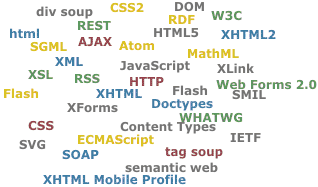Thursday, March 29, 2007
X/HTML5

Some people in the vicinities of the web standardization group W3C (but not directly the W3C) are working on a new version of HTML/ XHTML called HTML 5 (or Web Hypertext Application Technology or X/HTML5). Other efforts at the W3C go into the direction of XHTML2, but these two aren’t compatible or truly befriended.
HTML standards continue to be a whole big confusing mess – just count the number of names & abbreviations in this post – and this latest movement, which is still in very early stages, will not change this. A lot of these discussions are loaded with history (“we can’t annoy the SGML people so we make HTML be part of SGML!”), politics, bugs (browsers often completeley ignoring standards – say, mobile IE takes the desktop CSS even if you provide a mobile CSS), subtleties, misunderstandings, lags (it takes years for a recommendation to take shape, and additional years to never for every browser to implement it), ignorance, paradoxes (“browsers don’t implement what web developers don’t use, and web developers don’t use what browsers don’t implement – how do you introduce a new feature?”), fears (“font tags are evil” [be very afraid, X/HTML supports the font tag!]), accusations (“if you’re serving XHTML without the XML content type you’re creating tag soup” and “if you use too many divs you’re creating div soup”) and promises (“the next standard [say, Atom!] will clean it all up [say, RSS!] instead of adding even more spec to support”), and you’re often reminded of the scene in Life of Brian where people get into heated arguments over subtleties of how to follow their prophet – and which prophet to follow in the first place.
If this sounds like a nightmare, I have to add I think today’s real-life web development framework is paradise – you can do a whole lot of cool things supported in a whole lot of browsers, and if you ever developed bigger stylesheets for Netscape 4 some years ago, you probably know what I mean. I’m greatly enjoying the mixture of (X)HTML, JS and Ajax, CSS2 and media files like PNG, along with a server-side language & database of choice, to create web applications. These days you can get results very fast without worrying too much about browser incompatibilities or little hacks, as long as you know the kind of stuff you better avoid, and as long as you don’t take specs too literal.
We can hope though that this working group along with browser vendors and big web companies will create interesting technology inspirations to aid authors to create web applications. The group gives an example, saying that “currently HTML forms do not specify a way to specify that a control is a required control that must be filled in before submission: such features have to be scripted explicitly.” Other working drafts aim to deliver “[a]dvanced widgets like RTF controls, menus and toolbars.”
What’s interesting here is that the editor of the included Web Applications 1.0 and Web Forms 2.0 working drafts (itself related to XForms) is Ian Hickson... who works at Google Our-homepage-fails-with-46-validator-errors Inc.
[Via the Google Code Blog.]
>> More posts
Advertisement
This site unofficially covers Google™ and more with some rights reserved. Join our forum!
